Serbisyo Caravan:
Bringing government services at the doorsteps of an isolated
community in San Julian, Eastern Samar
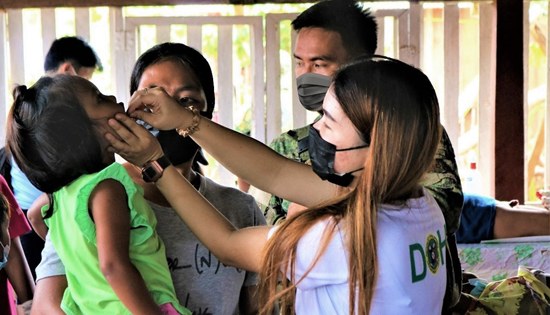
By
78th Infantry
Battalion, 8ID PA
October 14, 2021
BORONGAN CITY, Eastern
Samar – A total of seventy-seven (77) families from the
far-flung sitios of Pala-uno and Karuyagon, under Barangay Putong,
San Julian, Eastern Samar have benefited from the Serbisyo Caravan
on 12 October 2021.
The hinterland sitios are
located at the tri-boundaries of San Julian, Borongan City, and
Hinabangan. The roads are unpaved and inaccessible for any type of
vehicles.
The absence of government
services in the areas mentioned in the past years had made such
communities a fertile ground for the Communist NPA Terrorists (CNT)
to plant seeds of subversion and rebellion. This was proven during
an encounter between the government forces and the CNT last July of
2021 wherein NPA casualty was identified as a resident in the said
locality.
To break the influence of
Communist Terrorist Group in the area, and more importantly to
provide much needed social services to the communities, the 78th
Infantry Battalion and the Local Government Unit of San Julian
joined hands in bringing various programs and services right at the
very doorstep of the community to make them feel that the government
is present and working to uplift their lives.
Hon. Dennis P. Estaron,
the Mayor of the Municipality of San Julian is very much thankful
for the collaborative efforts of all the members of the Municipal
Task Force in Ending Local Communist Armed Conflict (MTF-ELCAC).
Mayor Estaron states: “We, in partnership with other government
agencies are doing our best to address the existing socio-economic
problems in the municipality”.
The 78th Infantry
(Warrior) Battalion, under the leadership of Lt. Colonel Oliver C
Alvior, clearly displayed during this activity that it is a reliable
and committed partner to the different MTF-ELCAC partner agencies.
The 78th Infantry (Warrior) Battalion will continuously be a
productive partner with ELCAC agencies by actively participating in
winning the peace and finding solutions on the issues used by the
CTGs in manipulating and exploiting the masses.
As stated by Lieutenant
Colonel Alvior: “This is a manifestation that we are serious in our
efforts to achieve the goal for permanent and peaceful closure of
all armed conflicts with non-state groups. We will give you the full
assurance that your army, in partnership with other stakeholders in
Eastern Samar, will support you and we will be your partners for
peace and progress.”
Various services were
provided by the different departments of both the municipal and
provincial local governments concerned. The efforts of the caravan
literally brought the government closer to the people it is mandated
to serve.
The wholehearted response
of the local populace during the activity had provided a glimpse to
the reality that the Communist Terrorist Group (CTG) is losing the
moral high ground, because the issues being exploited by them are no
longer relevant. Furthermore and more importantly, their unfulfilled
promises of a better life are continuously being shown as the lies
they truly are.
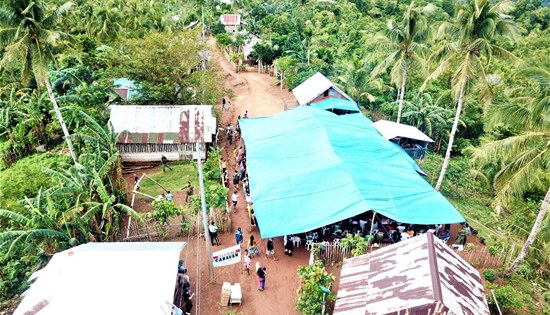
Young artist from
Leyte gets assistance from DOLE
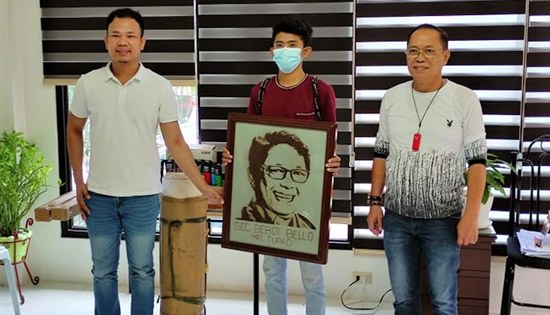
By
NORMA RAE S. COSTIMIANO
October 14, 2021
TACLOBAN CITY –
Connie Frances Fumar, a young painter from Palo, Leyte can now
pursue and improve his talent in painting and other forms of art
through the livelihood assistance provided by the Department of
Labor and Employment Regional Office No. 8 through its North Leyte
Field Office.
No less than DOLE
Assistant Secretary Victor A. Del Rosario, assisted by Regional
Director Henry John S. Jalbuena, awarded the arts and crafts
livelihood project worth more or less P30,000.00 to Fumar last
October 12, 2021 at the DOLE Regional Office.
Fumar, 21 years old, is
currently a 2nd year college student at AMA Computer Learning
College in Tacloban City taking up Information Technology.
As a proof of his unique
and artistic gift, Fumar created a masterpiece out of DOLE Secretary
Silvestre “Bebot” Bello’s portrait using rusts. When asked how he
came up with the idea of using rust as his primary material in the
said artwork, he said he just wanted to bring to a higher level his
natural skill.
“I know I have the skill
but I thought I can still bring it to the next level by using a
material that others may just take for granted like rusts from the
metals and other scrap materials”, said Fumar.
Asec. Del Rosario was
amazed at the works of Fumar and encouraged him to be more
passionate in the things he love to do.
“I really am in awe how
rusts can be turned into a great work of art and I hope you will
continue doing your craft more passionately and inspire others to
pursue their natural talents”, said del Rosario.
Director Jalbuena informed
that DOLE gave Fumar tools and materials so that he can also earn
income while enhancing his talent in arts.
“We are hitting two birds
with one stone here. With this livelihood grant, Connie can pursue
and enhance his craft while earning and making a living”, said
Jalbuena.
Fumar received the
following during the simple turnover activity: jigsaw, wood, canvass
cloths, nails, paints, wooden easel, paint brush set and other art
materials.
Aside from the livelihood
project, Fumar likewise received P30,000.00 stipend under the
department’s Tabang OFW program since his mother was an OFW affected
by the COVID-19 pandemic.
Fumar expressed his
gratitude to DOLE for all the help he received.
“I am very thankful to
DOLE for helping me pursue what I love as an artist. Not only that,
they also extended financial assistance so I can finish my studies
despite the pandemic. These really inspire me to achieve the best I
can”, Fumar ended.
Also present to facilitate
the awarding of livelihood was Mr. Norman L. Uyvico, Head of DOLE-NLFO.
(with report from DOLE-NLFO)
Inflation rate in
Eastern Visayas increases to 3.5% in August 2021
By
PSA-8
October 1, 2021
TACLOBAN CITY –
Inflation Rate (IR) in Eastern Visayas increased to 3.5 percent in
August 2021, the highest in the region of the last 12 months. This
IR is 0.3 percentage point higher compared with the 3.2 percent IR
in July 2021. This August IR of the region is also 1.2 percentage
points higher than the recorded 2.3 percent IR in the same period
last year.
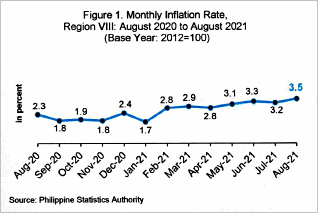 In comparison with the national average IR, the regional IR is still
lower by 1.4 percentage points than the 4.9 percent national IR in
August 2021.
In comparison with the national average IR, the regional IR is still
lower by 1.4 percentage points than the 4.9 percent national IR in
August 2021.
Among the provinces, Eastern Samar posted the highest IR at 6.3
percent in August 2021. Samar’s IR came next at 6.0 percent, then
Biliran at 5.4 percent. The lowest IR was noted in Leyte at 2.2
percent. Biliran, Northern Samar, Leyte, and Eastern Samar
registered higher IRs in August 2021 compared with their figures in
July 2021.
Biliran and Northern Samar recorded the highest increase in IR both
at 0.9 percentage point. Biliran grew to 5.4 percent in August 2021
from 4.5 percent in July 2021. Northern Samar went up to 2.4 percent
in August 2021 from 1.5 percent in July 2021. Leyte’s IR increased
to 2.2 percent in August 2021, recording 0.5 percentage point growth
from its 1.7 percent IR in July 2021. IR in Eastern Samar inched up
by 0.2 percentage point pushing its IR to 6.3 percent in August
2021.
On the other hand, the provinces of Samar and Southern Leyte
recorded decreases in their IRs in August 2021 by 0.9 percentage
point and 0.1 percentage point, respectively. Samar declined to 6.0
percent in August 2021 from 6.9 percent in July 2021. Southern Leyte
eased to 2.8 percent in August 2021 from 2.9 percent in July 2021.
Transport commodity group continued to post the highest IR at 9.3
percent. This was followed with the IR of alcoholic beverages and
tobacco commodity group (7.1%), and housing, water, electricity, gas
and other fuels commodity group (5.1%). All the other commodity
groups have IR lower than the IR for all items recorded at 3.5
percent.
Majority of the 11 commodity groups in the region exhibited lower
IRs in August 2021 compared with their rates in August 2021.
However, these were offset by the higher IRs recorded in three (3)
commodity groups, which resulted to 0.3 percentage point increase in
the overall IR of the region in August 2021.
The transport commodity group and furnishings, household equipment,
and routine maintenance of the house commodity group both registered
the biggest decrease in IR by 1.0 percentage point. Transport
commodity group settled at 9.3 percent in August from its
double-digit IR of 10.3 percent in July 2021, while IR for
furnishings, household equipment, and routine maintenance of the
house commodity group declined to 1.4 percent in August 2021 from
2.4 percent in July 2021.
The IRs for the commodity groups of restaurants and miscellaneous
goods and services, and health both managed to shed off 0.8
percentage point from their IRs in July 2021 registering 1.7 percent
and 1.2 percent IRs, respectively, in August 2021.
Compared with their July 2021 levels, IRs for clothing and footwear
commodity group (1.7%) and alcoholic beverages commodity group
(7.1%) were lower by 0.5 percentage point and 0.2 percentage point,
respectively in August 2021. Communication commodity group’s IR
eased by 0.1 percentage point settling at 0.9 percent in August
2021.
On the other hand, housing, water, electricity, gas and other fuels
commodity group recorded 5.1 percent IR in August 2021, higher by
1.5 percentage points from its 3.6 percent IR in July 2021. This
growth can be attributed to higher IR in the indices for
electricity, gas, and other fuels (15.1%) and water supply and
miscellaneous services relating to the dwelling (0.9%).
Food and non-alcoholic beverages commodity group registered a 0.7
percentage point increase in IR, from 2.6 percent in July 2021 to
3.3 percent in August 2021. Lower IRs and deflations were noted in
majority of the items under this commodity group. Fruits index
registered the highest decrease of 0.9 percentage point, from 2.6
percent IR in July 2021 to 1.7 percent IR in August 2021.
The IR for non-alcoholic beverages declined by 0.4 percentage point
from its 0.6 percent IR in July 2021, posting 0.2 percent IR in
August 2021. Slower price increases were also noted in the indices
for food products not elsewhere classified (2.8%) and oils and fats
(1.9%). Corn, rice, and bread and cereals further deflated to 1.7
percent, 1.6 percent, and 1.2 percent, respectively in August 2021.
However, these decreases were offset by the increases registered in
four (4) food items. Vegetables index registered the highest
increase in IR at 3.0 percentage points, from 1.6 percent in July
2021 to 4.6 percent in August 2021.
IR for fish index registered 2.6 percentage points increase posting
a double-digit IR of 10.1 percent in August 2021. Meat index
continued to register double-digit IR at 11.6 percent in August
2021, higher by 1.3 percentage points from its 10.3 percent IR in
July 2021. Higher price increases were also noted in the index for
sugar, jam, honey, chocolate, and confectionery at 2.0 percent.
Milk, cheese, and eggs retained its previous month’s IR at 1.3
percent.
The commodity group for recreation and culture, which registered a
1.6 percent deflation in July 2021 recorded price increases in
August 2021 at 1.7 percent.
The Purchasing Power of Peso (PPP) of the region remained at P0.76
in August 2021. This PPP implies that the goods and services worth
P76.00 in 2012 are now worth P100.00 in August 2021.
Compared with their levels in July 2021, PPP in Biliran and Northern
Samar weakened by P0.01. The rest of the provinces retained their
previous month’s PPP. Biliran and Leyte recorded the strongest PPP
among provinces in August 2021 at P0.79. Southern Leyte ranked
second at P0.78, followed by, Eastern Samar at P0.73, and Northern
Samar at P0.71. Samar posted the weakest PPP during the reference
month at P0.69.
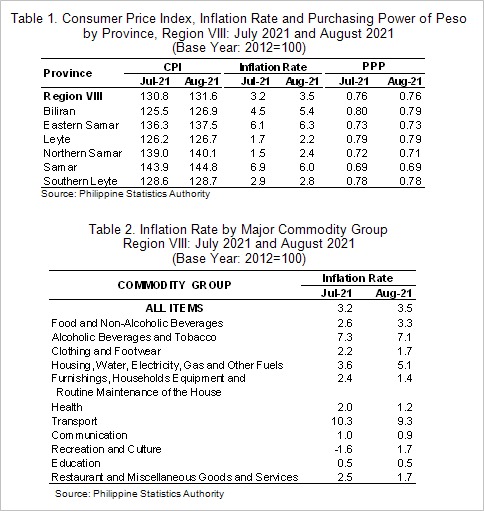
CARD MRI responds
to Typhoon Jolina’s aftermath
By
CARD MRI
October 1, 2021
SAN PABLO CITY –
When Typhoon Jolina struck parts of Luzon and Visayas on September
8, 2021, CARD Mutually Reinforcing Institutions (CARD MRI) reached
out to disaster-stricken communities, particularly in CALABARZON,
MIMAROPA, Bicol, Samar, and Leyte.
CARD Mutual Benefit
Association (CARD MBA) and CARD Pioneer Microinsurance, Inc. (CPMI),
the microinsurance arm of CARD MRI, came to the aid of its member
communities in CALABARZON, National Capital Region (NCR), Marinduque,
Masbate, Oriental and Occidental Mindoro, Camarines Sur, Camarines
Norte, Eastern Samar, and Leyte.
Through its CARD MRI
Disaster Relief Assistance Program (CDRAP), CARD MBA provided cash
assistance to affected members in their community. As of September
27, 2021, the association has reported 10,340 affected members and
has disbursed an equivalent amount of P1,240,800 of cash assistance.
Meanwhile, CPMI has
disbursed claims amounting to P3,790,250 as of September 28, 2021.
These claims were disbursed to policyholders covered under the Sagip
Plan, a family insurance package which covers damaged houses due to
natural calamities like typhoons.
Further, affected
policyholders of Typhoon Kiko have received P220,500 amount of
claims from their BINHI and crop assistance as of September 28,
2021.
The claims validation and
disbursement of cash assistance are currently ongoing for clients
affected by Typhoon Jolina and Typhoon Kiko.
“Immediate response in
calamities such as typhoons is very crucial for our microinsurance
group in CARD MRI. In times when we are most needed by our members,
CARD MBA and CPMI ensure that we can be relied on,” said CARD MBA
CEO Jocelyn D. Dequito.
The Disaster Plan
The Disaster Management
Committee, led by Legal and Security Operations Unit Director
Deolito Valdemar and is comprised of the microfinance operations
team, CARD MBA, BotiCARD, and other institutions of CARD MRI,
monitored Typhoon Jolina while it was outside the Philippine Area of
Responsibility (PAR). Its direction, speed, and strength as well as
the areas it will fall on were among those that were monitored by
the Central Monitoring System (CMS), which is responsible for
reporting to the committee chairman.
To mitigate the effects of
the typhoon and to avoid damage to people’s lives and their
properties, the Disaster Management Committee also sent an IT and
CMS text blast to warn the branches, especially those that are
located in places prone to flood, tsunami, storm surge, and
landslide.
After Jolina struck Luzon
and parts of Visayas, the committee checked the affected branches,
members, and staff, while CPMI validated the affected policyholders
covered under Sagip Plan, and CARD MBA disbursed the cash assistance
to members covered under CDRAP.
“The speed by which we
assist our clients is vital in situations like this,” shared CARD
MRI Managing Director Aristeo A. Dequito. He continued, “It is
important that we reach our clients as soon as possible so as not to
burden them further with the pandemic underway. With the help of our
Disaster Management Committee and the digital strategies we have
employed for a safer and easier claims validation and disbursement,
I remain optimistic that we may serve as a beacon of hope to our
policyholders during this trying time,” concluded Dequito.
Calbayog
Diversion to Guinbaoyan road is now passable
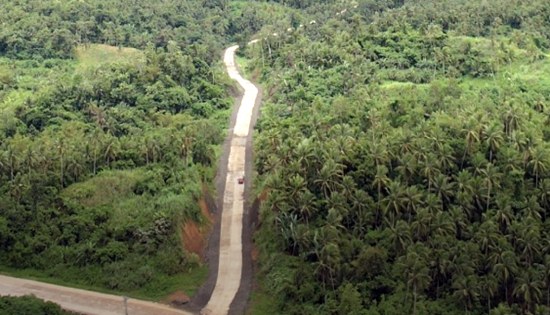
By
GISSELLE G. PARUNGAO
September 28, 2021
CALBAYOG CITY – In
order to provide faster, reliable and accessible route for farmers,
motorists and locals to reach the nearest market place and the city
proper, phase II of Calbayog Diversion to Guinbaoyan road is now
passable.
Funding of said project
was drawn from the General Appropriations Act (GAA) of 2021 with a
total contract amount of P38.8 million.
The project spans a total
of 1.6 kilometers of Portland Cement Concrete Pavement (PCCP) and a
total of 90.2 meters of stone masonry and hand laid rocks with a
width of 6.1 meters. Also, 58 pipe culverts were installed to allow
the flow of water supply to surrounding farmlands.
It can be recalled that
the construction of gravel road on this area started in 2018
allowing access to Calbayog City proper and nearby market where
farmers and entrepreneurs alike can sell their produce. This will
eventually gain economic growth for the city and source of income
for the locals.
Rehiring of Pinoy
seafarers rises due to LGU vaccination of mariners
By
ALU-TUCP
September 27, 2021
QUEZON CITY – The
rehiring of Filipino seafarers – the most sought-after seafarers in
the global seafaring industry – is rising, thanks to local
government units' inclusion of Filipino seafarers into their COVID19
vaccination program, said the workers group the Trade Union Congress
of the Philippines (TUCP).
The deployment of Filipino seafarers fell to 252,000 in 2020 from
470,000 in 2019 due to the pandemic lockdown restrictions in the
country and in ports around the world.
"But at the growing rate the national and local government units are
now vaccinating our seafarers, we are optimistic that we can reach
our target number of Filipino seafarers completely vaccinated and
ready for redeployment by the end of 2021. We will continue to work
with the national and local governments to provide more jabs for our
seafarers in their vaccination program," said TUCP President and
TUCP Party-list Rep. Raymond Mendoza.
Mendoza thanked Marikina City Mayor Marcy Teodoro for the
inoculation of deployment-ready 300 more members of the Associated
Philippine Seafarers' Union (APSU) and Associated Maritime Officers'
and Seamen's Union of the Philippines (AMOSUP) with vaccine brands
preferred by shipowners abroad.
The vaccination held at the Marikina Sports Center materialized with
the coordination between seafarers unions APSU, AMOSUP and the Joint
Manning Group (JMG) with the city government.
With that activity, the TUCP placed the total vaccinated Filipino
seafarers close to 100,000 since the vaccination began in May this
year.
Mendoza said before the pandemic the country deploys an average of
400,000 Filipino seafarers per year to work in 51,400 merchant ships
around the world.
The Inter-Agency Task Force on Emerging Infectious Diseases (IATF)
in May this year changed the classification of seafarers in the
order of priority vaccination from B3 category to A4 category and to
A1 category as frontline essential sector category for those with
immediate deployment contracts following a joint lobby between TUCP,
seafarers unions and local manning agencies.
According to the global union federation the International Transport
Workers Federation (ITF), Filipino seafarers are the backbone of
global shipping industry.
Before the pandemic, twenty five per percent of the 1.7 million
marine workers in 51,400 cruise and merchant ships transporting oil,
food, medicines and other essential products to and from different
parts of the world are Filipinos making them the largest group of
seafarers.
Filipino seafarers are preferred by shipowners and manning agencies
abroad because they have a legacy for being good communicator,
hardworking, multi-skilled and professional workers.
In 2019 alone, more than a quarter of the world's 1.6 million
seafarers come from the Philippines with 470,000 Filipino seafarers
contributed to almost US $7 Billion to the Philippine economy.
However, by the end of 2020 or nine months after the March 2020
lockdown, the Philippine Overseas Employment Administration (POEA)
recorded deployed seafarers not exceeding 200,000.
Meanwhile, APSU National President Michael Mendoza urged the local
government units to accommodate more seafarers into their local
vaccination programs.
Thus far, only seven Local Government Units allow vaccination for
seafarers. These are Manila, Pasig, Taguig and Las Piñas cities in
Metro Manila and Cebu City, Iloilo City and Davao City.
"We are on track but we need additional city mayors to commit
vaccination slots for our seafarers and contribute to bigger and
faster redeployment of our seafarers. The more vaccinated seafarers
that we deploy, the greater chances we can retake our place as the
most sought after seafarer in the world shipping industry," Mendoza
said.
Filipino seafarers contribute significantly to the global supply
chain and help keep our local economy afloat through the financial
remittances to their families back home.
Before the pandemic, the Philippines is the biggest supplier of
seafarers hired by shipowners followed by China, Indonesia, Russian
Federation, Ukraine, Vietnam, and Myanmar.
Environmental
groups push for green electoral reforms ahead of the 2022 polls
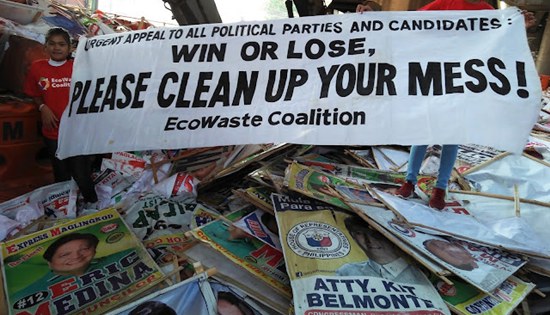
Press Release
September 26, 2021
QUEZON CITY – As
the election fever heats up across the country, environmental groups
wasted no time in urging the Commission on Elections (COMELEC) to
initiate much-needed reforms toward an eco-friendly conduct of the
2022 polls.
Through a letter submitted
last Friday to the office of COMELEC Chairman Sheriff M. Abas,
pro-environment groups led by the EcoWaste Coalition, Greenpeace
Philippines, Mother Earth Foundation, and Zero Waste Philippines
appealed to the poll body “to proactively integrate waste and toxic
prevention in the conduct of the upcoming elections.”
The groups, along with the
Cavite Green Coalition, Interfacing Development Interventions for
Sustainability, Oceana Philippines, NASSA/Caritas Philippines, Urban
Poor Associates and a host of other community-based organizations,
made the earnest appeal ahead of the filing period on October 1 to 8
for the Certificates of Candidacy for all elective positions, as
well as the certificates of nomination and acceptance.
“Considering the problems
already plaguing our society due to garbage, plastic pollution,
climate change and COVID-19, we urge the COMELEC to champion much
needed policies and practices that will protect our fragile
environment from being further degraded by the avalanche of partisan
political activities leading to the 2022 elections,” wrote Eileen
Sison, President, EcoWaste Coalition.
“We hope COMELEC will
commit to greening the 2022 polls to the best of its ability and
with the participation and support of all stakeholders,” she said,
noting the widespread disregard of environmental rules and
regulations in past electoral exercises.
The groups identified some
of the more blatant offenses in previous polls that have directly or
indirectly harmed the environment, including the unrestrained
plastering of campaign posters outside COMELEC-designated areas,
most notoriously on trees, electric posts and walls.
The groups also scored the
unbridled display of “indirect” political propaganda such as
graduation and fiesta banners and tarpaulins; the unregulated noise
from mobile political propaganda and during campaign meetings; the
unchecked distribution and littering of sample ballots on election
day; the open burning of campaign waste materials, which is
prohibited under the Clean Air Act and the Ecological Solid Waste
Management Act, and the failure to avoid the use of single-use
plastics and adding to the mounting plastic pollution that ends up
in the waterways and the ocean.
“We have also observed the
rampant use of campaign materials that are hardly reused or
recycled, particularly plastic tarpaulins, posters and buntings, as
well as the confetti thrown in miting de avance,” the groups said.
Aside from the littered
sample ballots on the actual polling day, the groups also noted the
use of disposable food and beverage containers inside the polling
centers for the members of the Board of Election Inspectors, poll
watchers and volunteers, and the lack of an ecological system for
managing discards such as food leftovers and their single-use
containers.
To reduce the ecological
footprint of the much anticipated elections in 2022, the EcoWaste
Coalition requested COMELEC to heed the following action points:
a. Adopt a resolution
declaring and enunciating Zero Waste as a policy to effectively
prevent and reduce the generation of garbage, including COVID-related
waste such as used face masks and face shields.
b. Create a special
committee that will take the lead in the multi-stakeholders task of
“greening” the elections and the strict enforcement of relevant
environmental rules and regulations.
c. Require all individuals
and groups running for election to abide by the Ecological Solid
Waste Management Act, which, among other prohibited acts, bans
littering, open dumping and open burning of waste.
d. Make it mandatory for
parties and candidates to make use of recyclable and reusable
materials free of hazardous chemical substances for their electoral
campaign, and for them to conduct compulsory post-election clean-up.
e. Use its moral authority
to encourage parties and candidates to articulate in their electoral
platforms how they plan to advance the state policy, as written in
the Constitution, to “protect and advance the right of the people to
a balanced and healthful ecology in accord with the rhythm and
harmony of nature.”
f. Incorporate
environmental awareness and responsibility in the COMELEC's public
information drive for clean, orderly, peaceful, honest and fair
elections.
g. Regulate campaign
motorcades, if not impose an outright ban, to address perennial
problems with traffic congestion, noise, air pollution and climate
change.
h. Work with the
Department of Health to set regulations on poll campaign noise.
i. Strictly enforce the
laws, rules and regulations on proper posting of campaign materials
and enforce sanctions to those who violate them.
The EcoWaste Coalition
will also reach out to political parties and political wannabes to
encourage them to think of the environment as they ardently woo the
electorate for votes.